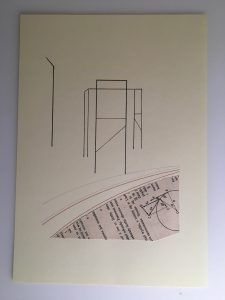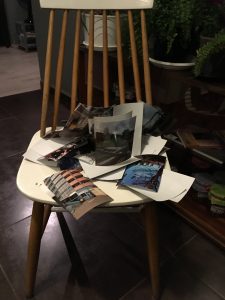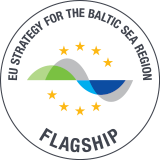From 9 November to 1 December, 2019, residency artists Inga Erdmane and Edd Schouten explored the neighbourhood of Nowy Port in Gdansk in order to provide a fresh view on the potentials of the area. In the following interview, you can read about their thoughts and reflections on their first encounter with Nowy Port.
Inga Erdmane and Edd Schouten are both graduates from The Hauge, Royal Academy of Fine
in Holland. Schouten graduated from the department of Art Science in 2005, and Erdmane from
the photography department in 2012. Along their individual art, they have been working on shared
art projects since 2016. Furthermore, Inga and Edd have participated in three residencies as part of the Urb Cultural Planning project – two in Riga and the latest being Nowy Port in Gdansk.
What was your first impression of the district?
“We drove from Riga to Poland, to Gdansk, to Nowy Port. It reminded us how closely related we actually are. Latvia often feels a little isolated but in few hours you can be in the heart of Poland. It’s interesting to see the difference between the three countries we crossed. It was immediately apparent that you’re in a different country when you cross the border into Poland from Lithuania. There was a lot of visual pollution in the way of billboards and a cacophony of traffic signs. Lots of things going on along the road as well.
Once off the major roads that abruptly stoped as we drove through the stunning countryside, there was a roughness to the landscape. It felt more primal, even the agricultural stretches were much less rigid in their geometry compared to other places. There were lots of big lakes, and trees lined the roads and appeared to have doing so forever. In the towns and villages, we saw the disposition to billboards and roadside advertising. Perhaps more obvious here because of the stark contrast between their gaudy design and the genuine beauty of the buildings and surrounding nature.
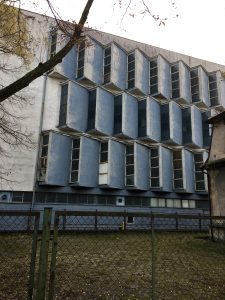 “As we got closer to Gdansk, the infrastructure got better. It was dark early (in November) and we were happy to switch from the unlighted, winding roads to first one-lane and then two-lane highways. The roads were brand new. The infrastructure impressed us as we drove into Nowy Port by taking a modern tunnel under the canal. The modernity of Poland is something we had not expected, but it is what stood out the most in these first hours. An example of this was also the contemporary design of logos seen along the way. It looked fresh, as if the graphic designers were working on it only yesterday.
“As we got closer to Gdansk, the infrastructure got better. It was dark early (in November) and we were happy to switch from the unlighted, winding roads to first one-lane and then two-lane highways. The roads were brand new. The infrastructure impressed us as we drove into Nowy Port by taking a modern tunnel under the canal. The modernity of Poland is something we had not expected, but it is what stood out the most in these first hours. An example of this was also the contemporary design of logos seen along the way. It looked fresh, as if the graphic designers were working on it only yesterday.
First impressions of Nowy Port were of the quiet and the lack of things to do. The first days were extra calm because of the national holiday which gave us a good opportunity to explore in silence. We sometimes felt a little unsafe because of alcohol induced aggression (not towards us directly, from a distance) and stereotypes that come with social housing. We felt a sense of history even though there is not a great deal of it on display. The fact that the first shot of WWII was fired from the lighthouse made an impact on us emotionally.”
How did you collaborate with the neighbourhood of the district? Describe what happened?
“We didn’t interact much with the local population, it didn’t feel natural somehow. But, in time, we did have some interactions with local residents. One in particular, an architect and urban planner we met at an opening, gave us some interesting insights. She also invited us to her garden plot and apartment, uncovering a rare peek behind the scenes of the Nowy Port resident. Everything happens behind walls, curtains, and fences, so it was nice to have a few moments there. For the rest, our collaboration was fairly one-sided. We were inspired by the space and responded through photographs and drawings.”
How did the place change during your work? How do you perceive this neighbourhood now? What drew your attention – what places, people, behaviours?
.”The danger subsided, there is little sense of it now. The quiet was confirmed, especially that there was not much to do. One cafe (more of a cake shop) and a bistro are the only places where one can sit during the day… or in the evening for that matter; it only gets worse by the night. It was interesting that almost everyone who lives in Nowy Port seems to work, study and play outside of the district,. The public transportation is excellent with the tram running frequently. The fact that there is no way to cross the canal is surprising and depressing. The distance to the center is quite far which is both a blessing and a curse. There is a great cultural center which offers many activities to the district residents. Not sure how many also take advantage of this but the opportunity is there.”
How do you imagine the future of this district?
”Hopefully, the district can restore some of its past. There were bars and restaurants here which dwindled after WWII and there is no reason for this not to return. The bars have now been replaced by alcohol shops, and people rather stay home to socialise. But a little investment and incentive could see these spaces return. There must be an interest for the Gdansk, Sopot, or Gdynia residents who are not in the mood to deal with the thousands of tourists in their own districts. We think that the cultural institutions, existing in the district, can play an important part in the positive development and could also contribute to the empowerment of the local population, especially the youth.
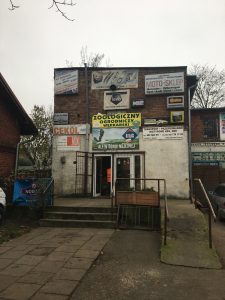
Laznia has a great infrastructural position and already organizes many workshops and other creative activities. ‘180 Degrees’ is a youth group that focuses on street art and hip hop which is popular among young people in the district. Mewka is an art space that broadens the scope to more contemporary artistic expressions and is looking to involve the local community, and has been doing so for five years.
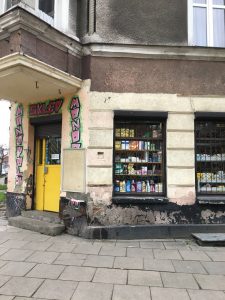
The artists running these spaces are all invested in Nowy Port and the positive development of the space. Bartosz Zimniak, who runs Mewka, would be an interesting artist to involve for a UCP residency as he is well situated to create work that involves the local community and has the gallery at his disposal. His perspective would offer an interesting contrast that ours, as complete strangers to the district, could not. His residency could have longer lasting repercussions for the community.”
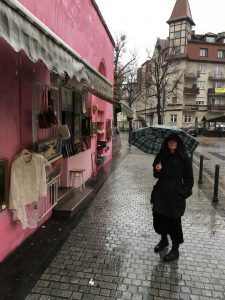
What do you think will happen here in the coming years?
”It’s hard to say. It doesn’t look like there will be terribly revolutionary things happening in the coming years. Nowy Port is a sleepy district and most people seem content to leave it that way. The money is in the center and the districts that are close to it. Let’s hope there will be some investment in the quality of life for the residents – upkeep of the buildings, more green, programs to help against addiction and poverty, access to the canal.”
What would you warn local people about?
.”Gentrification. The strength of Nowy Port is that it is far away from the centre where all the energy appears to be put into drawing increasingly more tourists. Although this is economically interesting, the centre doesn’t belong to the local residents any longer. Its turning into a Disney park, and all the development is to house the future tourists and to entertain them further. Its not worth it. It would be far more interesting to return the bars and restaurants from before the war to the district and try to draw local people in. But it should also be perfectly happy to remain a residential district where people can live in the relative calm and travel out for their entertainment.”
What do you think has a chance to develop in this environment?
.”The emergence of some more restaurants and a couple of bars or coffee places could do well in time. But it’s for the long haul. The residents of Gdansk are going to want to find a place where there still is some authenticity left. And where they can escape the tourists. This is Nowy Port main asset. It’s pleasant enough, but there is no reason for a tourist to travel all the way as there is not much of interest for them here.”
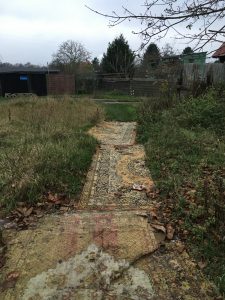
If you want to know more:
.
Throughout 2019, Urb Cultural Planning has organised 10 residencies in different neighbourhoods of the Baltic Sea region. The residency programme is designed to enable creative exploration, concentrated work and cultural exchange in an inspiring environment. By doing this, we move towards finding the best solutions for local challenges in the BSR, as well as new opportunities in cultural mapping. The 2019 residency programme can be found here.




